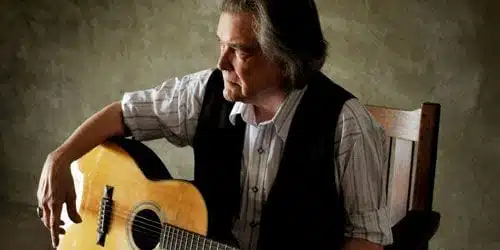
Even when Guy Clark was a young man, he sounded old. That was especially true when he sang from the perspective of being a boy, on such classics as “Desperadoes Waiting for a Train” and “Texas, 1947”. Clark did not sound like an adult reminiscing about the past, but he came off as an elderly gent remembering long ago. After all, Clark was the songwriter of “That OId Time Feeling”. He understood what it meant to “hold hands with the clock.”
Well, Clark’s an old man now. He’s 72 and sounds it. The Texas singer-songwriter’s gravelly voice has become even rougher with age. His line breaths are shorter. Most of his songs share a leisurely pace, even when he’s “Hell Bent on a Heartache”. But that doesn’t mean his mind has slowed. Clark still knows how to write a song, share a memory, and analyze the problems he sees around him. His delivery may be gentler, but Clark is no fool.
The 11 tracks on My Favorite Picture of You range in topic from sweetly recalling the past (“Cornmeal Waltz”) to post-traumatic stress syndrome caused by recent wars in the desert (“Heroes”) to the victims of illegal immigration (“El Coyote”) to the search for love (“Rain in Durango”). Clark unifies the diverse topics by personalizing them. He knows that “life is a bitter pill” and even “life’s a bitch, but it could be worse.” Clark doesn’t blame people for bad decisions, nor does he preach. Even when he does not sing in the first person, his empathy with the protagonist is always clear.
The two standout tracks here are the title track and his modern rewrite of the old folk tune, “Shady Grove”, titled “Death of Sis Draper”. The cut “My Favorite Picture of You” is a love song to his recently departed wife of 40 years, Susanna. Clark describes the elements of the photograph, from Susanna’s fierce facial expression as she looks directly into the camera to what was going in their relationship at the time the Polaroid was taken. Susanna was ready to leave him and mad as hell, but she stayed. The love he has for his late wife comes across as a statement of fact, just like the snap of the shutter. “Click”, he croons frankly. His feelings remain strong.
“Death of Sis Draper” uses realistic details to tell a story about a mythic fiddle player who “burned both ends of the candle” and was poisoned by a jealous woman. Not only does Clark borrow the tune from “Shady Grove”, but he name checks the old folk song as well. Otherwise, this song of travel and adventure shares little in common with the original. Clark tells a tall tale about a traveling musician with the sole purpose of entertaining. There is no moral to the story. Its only purpose is to keep the audience listening in suspense, which it does wonderfully.
Clark, a member of the Songwriters Hall of Fame, wrote or co-wrote all but one of the songs here. This is his first studio album in four years, and it shows he’s not lost his touch. He knows that a picture such as the photograph of his wife is worth a thousand words, but his words suggest much more than the surface image of a photo can ever reveal.

